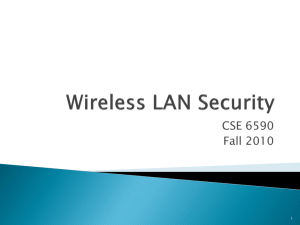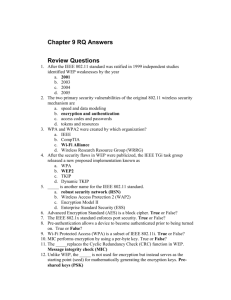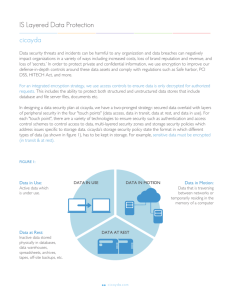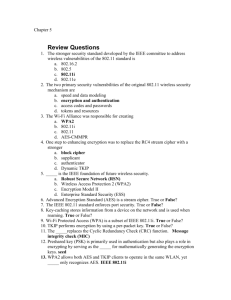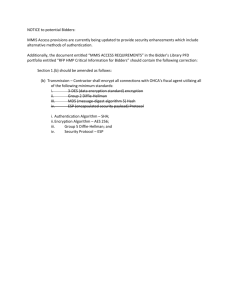Wireless LAN security
advertisement
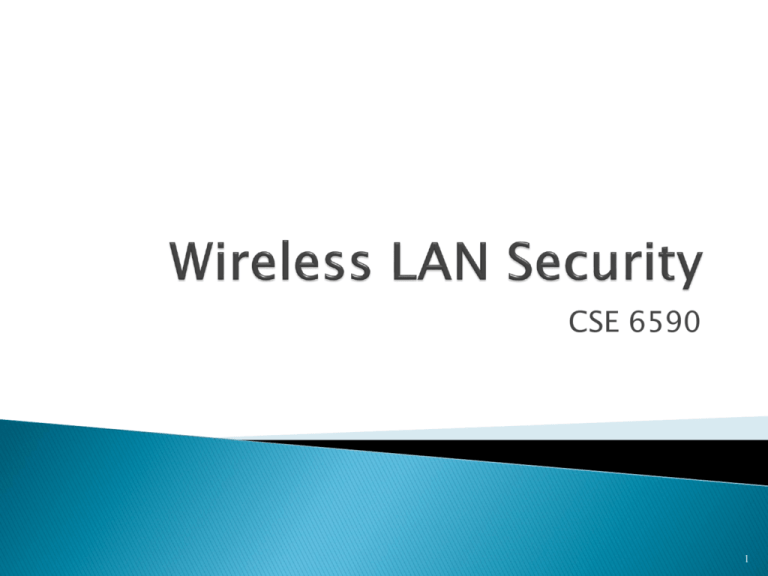
CSE 6590 1 Wired Equivalent Privacy (WEP) ◦ first security protocol defined in 802.11 Wi-Fi Protected Access (WPA) ◦ defined by Wi-Fi Alliance WPA2 802.11i 2 In the early 1980s, the IEEE began work on developing computer network architecture standards ◦ This work was called Project 802 In 1990, the IEEE formed a committee to develop a standard for WLANs (Wireless Local Area Networks) ◦ At that time WLANs operated at a speed of 1 to 2 million bits per second (Mbps) 3 In 1997, the IEEE approved the IEEE 802.11 WLAN standard Revisions ◦ ◦ ◦ ◦ IEEE IEEE IEEE IEEE 802.11a 802.11b 802.11g 802.11n 4 Access is controlled by limiting a device’s access to the access point (AP) Only devices that are authorized can connect to the AP ◦ One way: Media Access Control (MAC) address filtering ◦ CCSF uses this technique (unfortunately) ◦ See www.ccsf.edu/wifi 5 6 7 Usually implemented by permitting instead of preventing CCSF does this www.ccsf.edu/wifi 8 MAC addresses are transmitted in the clear ◦ An attacker can just sniff for MACs Managing a large number of MAC addresses is difficult MAC address filtering does not provide a means to temporarily allow a guest user to access the network ◦ Other than manually entering the user’s MAC address into the access point 9 Designed to ensure that only authorized parties can view transmitted wireless information Uses encryption to protect traffic WEP was designed to be: ◦ Efficient and reasonably strong 10 10 WEP secret keys can be 64 or 128 bits long The AP and devices can hold up to four shared secret keys ◦ One of which must be designated as the default key 11 12 13 One of the most common and powerful errordetecting codes. Given k bits of data, generate a sequence F of j bits (FCS) using a predetermined divisor P of (j+1) bits Transmit a frame of k+j bits (data + FCS) which will be exactly divisible by divisor P Receiver divides frame by divisor P ◦ If no remainder, assume no error 1 4 15 When a node has a packet to send, it first generates CRC for this packet as an integrity check value (ICV). Generates an IV; concatenates it with the secret key; applies RC4 to create RC4 key stream. Performs XOR operation on the above two streams, byte by byte, to produce ciphertext. Appends the IV to the ciphertext and transmits to the receiver. 16 17 18 IV is 24-bit long 224 choices. The probability of choosing the same IV value is more than 99% after only 1200 frames. Only a few seconds elapse with 11Mbps and 1KByte frame size. IV values are sent in plain text attackers can detect a duplicate value and re-use past keys. 19 Security hole: 24-bit IV, one IV per frame, -> IV’s eventually reused IV transmitted in plaintext -> IV reuse detected Attack: ◦ Trudy causes Alice to encrypt known plaintext d1 d2 d3 d4 … ◦ Trudy sees: ci = di XOR kiIV ◦ Trudy knows ci di, so can compute kiIV ◦ Trudy knows encrypting key sequence k1IV k2IV k3IV … ◦ Next time IV is used, Trudy can decrypt! 8: Network Security 820 Before a computer can connect to a WLAN, it must be authenticated Types of authentication in 802.11 ◦ Open system authentication Lets everyone in ◦ Shared key authentication Only lets computers in if they know the shared key 21 22 23 Authentication is first carried out via ◦ open system authentication, or ◦ shared key authentication Data packets are then encrypted using the WEP encryption process described above. Each packet requires a new IV. 24 Static WEP keys (no periodic updates) High frequency of repeating the same IV ◦ IVs are only 24-bit long ◦ Packets can be replayed to force the access point to pump out IVs. CRC is weak in integrity check. ◦ An attacker can flip a bit in the encrypted data and then change the CRC as well. Authentication is too simple. 25 26 Wireless Ethernet Compatibility Alliance (WECA) ◦ A consortium of wireless equipment manufacturers and software providers WECA goals: ◦ To encourage wireless manufacturers to use the IEEE 802.11 technologies ◦ To promote and market these technologies ◦ To test and certify that wireless products adhere to the IEEE 802.11 standards to ensure product interoperability 27 In 2002, the WECA organization changed its name to Wi-Fi (Wireless Fidelity) Alliance In October 2003 the Wi-Fi Alliance introduced Wi-Fi Protected Access (WPA) ◦ WPA had the design goal to protect both present and future wireless devices, addresses both wireless authentication and encryption PSK or 802.11X addresses authentication and TKIP addresses encryption 28 Key size increased to 128 bits Larger IVs: 48-bit long Changing security keys through Temporary Key Integrity Protocol (TKIP) ◦ Encryption keys are changed (based on a master key) after a certain number of packets have been sent. ◦ An IV is mixed with data (not concatenate). Ciphering scheme is the same as WEP ◦ compatible with old wireless LAN cards 29 WPA uses a new message integrity check scheme called Michael, replacing the CRC function in WEP. A frame counter is added to Michael to avoid replay or forgery attack. Note: Ciphering scheme is the same as WEP. ◦ Compatible with old WLAN cards 30 31 Two options: PSK (inexpensive, home/personal networking) 802.1X (expensive, enterprise networking) 32 Pre-shared key (PSK) authentication ◦ Uses a passphrase to generate the encryption key Key must be entered into both the access point and all wireless devices ◦ Prior to the devices communicating with the AP The PSK is not used for encryption ◦ Instead, it serves as the starting point (seed) for mathematically generating the encryption keys Results in a pair-wise master key (PMK) Followed by a 4-way handshake to handle key management and distribution, which uses the PMK to generate a pair-wise transient key (PTK). 33 34 A PSK is a 64-bit hexadecimal number ◦ Usually generated from a passphrase Consisting of letters, digits, punctuation, etc. that is between 8 and 63 characters in length If the passphrase is a common word, it can be found with a dictionary attack 35 People may send the key by e-mail or another insecure method Changing the PSK key is difficult ◦ Must type new key on every wireless device and on all access points ◦ In order to allow a guest user to have access to a PSK WLAN, the key must be given to that guest 36 Three components: ◦ Remote authentication dial-in user service (RADIUS) ◦ authenticator (access point) ◦ supplicant (client) Uses EAP authentication framework ◦ EAP-PSK, EAP-TLS, EAP-TTLS, EAP-MD5 Results in a pair-wise master key (PMK) Followed by a 4-way handshake to handle key management and distribution, which uses the PMK to generate a pair-wise transient key (PTK). 37 38 • AS verifies client’s digital signature using client’s public key got from client’s certificate Certclient • Get random number p by decrypting with its private key • Client calculates H(c,s,p), compares it with the value sent by As 39 40 41 42 43 Wi-Fi Protected Access 2 (WPA2) ◦ ◦ ◦ ◦ Introduced by the Wi-Fi Alliance in September 2004 The second generation of WPA security Still uses PSK (Pre-Shared Key) authentication But instead of TKIP encryption it uses a stronger data encryption method called AES-CCMP AES: Advanced Encryption Standard CCMP: Counter Mode with Cipher Block Chaining Message Authentication Code Protocol 44 PSK Authentication ◦ Intended for personal and small office home office users who do not have advanced server capabilities ◦ PSK keys are automatically changed and authenticated between devices after a specified period of time known as the rekey interval 45 AES-CCMP Encryption ◦ Encryption under the WPA2 personal security model is accomplished by AES-CCMP ◦ This encryption is so complex that it requires special hardware to be added to the access points to perform it 46 47 The most secure method Authentication uses IEEE 802.1x Encryption is AES-CCMP 48 49 A superset of all WLAN security mechanisms including WEP, WPA and WPA2. PSK (personal) or 802.1X (enterprise) is used for authentication and key management. 50 Section 6.3.1, Wireless Mesh Networks, by I. F. Akyildiz and X. Wang 51
